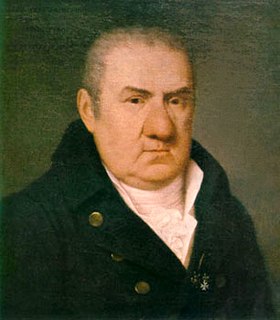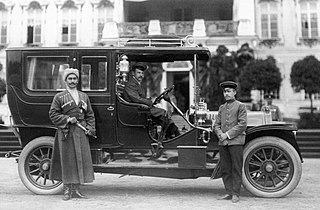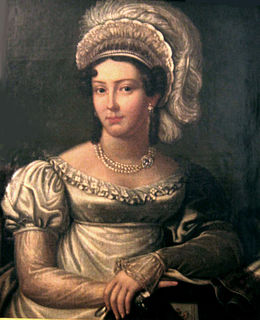
Pushkin is a municipal town in Pushkinsky District of the federal city of St. Petersburg, Russia, located 24 kilometers (15 mi) south from the center of St. Petersburg proper, and its railway station, Tsarskoye Selo, is directly connected by railway to the Vitebsky Rail Terminal of the city. Population: 92,889 (2010 Census).
Alexander Pushkin (1799–1837) was a Russian poet.

Tsarskoye Selo was the town containing a former Russian residence of the imperial family and visiting nobility, located 24 kilometers (15 mi) south from the center of Saint Petersburg. The residence now forms part of the town of Pushkin. Tsarskoye Selo forms one of the World Heritage site Saint Petersburg and Related Groups of Monuments.

The Imperial Lyceum in Tsarskoye Selo near Saint Petersburg, also known historically as the Imperial Alexander Lyceum after its founder Tsar Alexander I, was an educational institution which was founded in 1811 with the object of educating youths of the best families who would afterwards occupy important posts in the Imperial service.
Admiralty usually refers to:

Charles Cameron was a Scottish architect who made an illustrious career at the court of Catherine II of Russia. Cameron, practitioner of early neoclassical architecture, was the chief architect of Tsarskoye Selo and Pavlovsk palaces and the adjacent new town of Sophia from his arrival in Russia in 1779 to Catherine's death in 1796. All his indisputable tangible works "can be encompassed in a day's tour"; Cameron concentrated exclusively on country palaces and landscape gardens. Twice dismissed by Paul of Russia during the Battle of the Palaces, Cameron enjoyed a brief revival of his career under Alexander I in 1803–1805. Apart from the well-researched Catherinian period (1779–1796), Cameron's life story remains poorly documented, not in the least due to Cameron's own efforts to shake off the bad reputation he had earned in the 1770s in London.

Giacomo Quarenghi was the foremost and most prolific practitioner of neoclassical architecture in Imperial Russia, particularly in Saint Petersburg. He brought into vogue an original monumental style, of Palladian inspiration, which was a reference for many architects who worked in Russia.

Adolphe Kégresse was a French military engineer who invented the half-track and dual clutch transmission.

The Chesme Column is a rostral column in the Catherine Park at the Catherine Palace, a former Russian royal residence at Tsarskoye Selo, a suburb of Saint Petersburg. The column commemorates three Russian naval victories in the 1768–1774 Russo-Turkish War: the Battle of Chios, the Battle of Chesma and the Battle of Mytilene. It was constructed from 1774 to 1778 in the large pond of the landscape park of the Catherine Palace to Antonio Rinaldi's designs.

Joanna Grudzińska was a Polish noble, a Princess of Łowicz and the second wife of Grand Duke Constantine Pavlovich of Russia, the de facto viceroy of the Kingdom of Poland. This marriage cost Constantine the crown of Russia.

Saint John Alexandrovich Kochurov, hieromartyr of the Soviet revolution, was one of a number of young educated priests who came to the United States in the late 1890s as missionaries among the émigrés from Carpathian Ruthenia and Galicia. He was active in establishing parishes and aiding communities, mainly in the Midwest. After returning to Russia he was assigned to Estonia where he put into action the teaching skills he learned in America before he was assigned in 1916 to Tsarskoe Selo. Here he was killed during the early days of the Bolshevik revolution. His feast day is celebrated on October 31. He is also commemorated on the feast of the New Martyrs and Confessors of Russia, celebrated on the Sunday nearest to January 25, which was the date of the martyrdom of Metropolitan Vladimir of Kiev, the first of the new martyrs.

Adam Menelaws, also spelled Menelas was an architect and landscape designer of Scottish origin, active in the Russian Empire from 1784 to 1831. Menelaws achieved success in the first two decades of the 19th century as the designer of town and country residences and parks of Razumovsky and Stroganov families, and later worked for emperor Alexander I, specializing in Gothic Revival architecture. From 1825 to 1831 Menelaws, then in his seventies, became the first house architect of Nicholas I and de facto the leading architect of the Empire. Except for this final, properly evidenced, stage, life story of Adam Menelaws remains scarcely documented and has been reconstructed by biographers based on sketchy archive data and circumstantial evidence; Menelaws still "belongs to the category of almost unknown".

The Tsarskoye Selo Railway was the first public railway line in the Russian Empire. It ran for 27 km (17 mi) from Saint Petersburg to Pavlovsk through the nearby (4 km) Tsarskoye Selo. Construction began in May 1836, and the first test trips were carried out the same year between Tsarskoye Selo and Pavlovsk, using horse-drawn trains. The line was officially opened on 30 October 1837, when an 8-carriage train was hauled by a steam locomotive between Saint Petersburg and Tsarskoye Selo. Until the construction of the Moscow – Saint Petersburg Railway in 1851, it was the only passenger train line in Russia. In 1899 it was merged into the Moscow-Windau-Rybinsk Railways and now forms part of the Oktyabrskaya Railway.
Vasily Ivanovich Neyolov was a Russian architect, whose works are representative of early classicism and romanticism. He is notable as one of the first landscape park designers in Russia. Neelov served as a court architect in Tsarskoye Selo and worked with Francesco Bartolomeo Rastrelli on the construction of the Catherine Palace. Neyolov was the author of albums with plans of facades of buildings in Tsarskoye Selo. Neyolov was one of the first architects of Russian origin working in Tsarskoye Selo.
Dragon Bridge may refer to:

The Imperial railway station or Tsarskoye Selo Imperial Station, known as the Imperial Pavilion, is a former Tsarskoye Selo Railway station, which served the Imperial Tsarskoye Selo Railway.

Tsarskoye Selo railway station is a railway station located in Pushkin, Saint Petersburg, Russia. It is 23 km down-line from Vitebsky railway station and is situated between Shushary and Pavlovsk on the Saint Petersburg — Vitebsk line. The station hosts suburban trains from Saint-Petersburg, Novolisino, Posyolok, Oredezh, Luga and Veliky Novgorod. Electric trains ED4M, ER2T and DT1 make a passenger trips from Tsarskoye Selo station. Long-distance trains do not stop at Tsarskoye Selo station except train from Velikiye Luki. The station is approximately 1 km from the town center. It has official status as an object of Russian cultural heritage.

Pavlovsk railway station is a railway station located in Pavlovsk, Pushkinsky District of Saint Petersburg, Russia. It is 26 km down-line from Vitebsky railway station and is situated between Tsarskoye Selo and Antropshino on the Saint Petersburg — Vitebsk line. Also it combines route out of Novolisino and Tosno on the Saint Petersburg — Moscow line. The station hosts suburban trains from Saint-Petersburg, Novolisino, Posyolok, Oredezh, Luga and Veliky Novgorod. Electric trains ED4M, ER2T, DT1 and railbus RA2 make a passenger trips from Pavlovsk. Long-distance trains have not stop at Pavlovsk station. The station is approximately 1,4 km from the town center. It has official status as an object of Russian cultural heritage.













